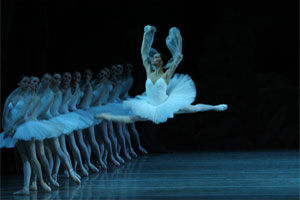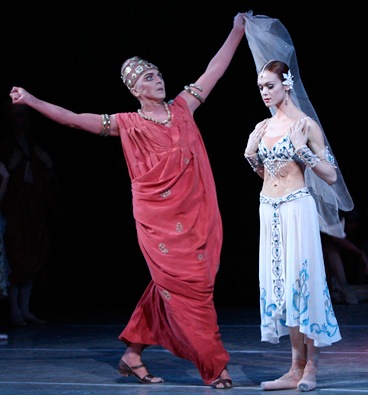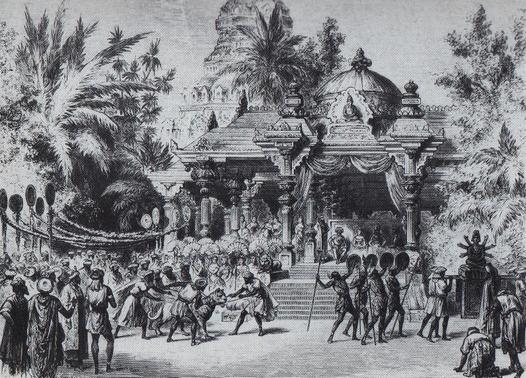La Bayadère, Mariinsky Ballet, Royal Opera House | reviews, news & interviews
La Bayadère, Mariinsky Ballet, Royal Opera House
La Bayadère, Mariinsky Ballet, Royal Opera House
The great company takes its leave in a landmark of balletic poetry

The bayadere bears on her shoulder a vase of holy water, and the story of the ballet La bayadère is of her refusal to compromise. She could better her life in two political deals: become the high priest’s mistress, or later, when bitten by a poisonous snake, take the antidote and live on while watching her sworn lover marry the princess who he knows tried to murder her. She refuses both. She remains, morally, the vessel of a purity that it would kill her spirit to give up.
To stay so true to a principle isn’t only the stuff of fantastical ballet fairy tales. It has to be true of the interpreters in the theatre who bear other people’s work on their shoulders, often, in theatre, not very great work - yet in ballet these interpreters can turn even base stuff into something sublime. La bayadère is only a 19th-century exotic melodrama created in 1877 more with an eye to divert than to move, but it can become a masterpiece when it’s given a performance as dedicated to the holy well as it had last night, the final one of the Mariinsky Ballet’s 2011 tour to Covent Garden.
As my colleague Judith Flanders reports today, in the absence of a worthy Swan Lake production, it’s La bayadère that has to do the honours for showcasing the Mariinsky’s purest stylistic beauty, above all in its unspeakably haunting final act, as white-tutu’d angels pour out of the Himalayas, in the ultimate vision of all classical ballet.
 And last night the corps de ballet lived up to the dream. A hypnotic file of ballerinas, in numbers that only the Mariinsky can field, emerged like glowing phantasms from the cavern, lilting forward and backwards in their arabesque parade, 32 identical shapes moving at all the same angles, hands and feet tapering in the same shining finish, the impression of multiple slivers of a new moon in remote, unattainable mountains.
And last night the corps de ballet lived up to the dream. A hypnotic file of ballerinas, in numbers that only the Mariinsky can field, emerged like glowing phantasms from the cavern, lilting forward and backwards in their arabesque parade, 32 identical shapes moving at all the same angles, hands and feet tapering in the same shining finish, the impression of multiple slivers of a new moon in remote, unattainable mountains.
Such simple, almost elementary steps these girls do, created by the miraculous choreographer Marius Petipa almost 150 years ago, but which the St Petersburgers have turned into their articles of faith. These are elementary ports de bras, elementary leg moves, letters of the ballet alphabet, the basis of the grand classical vocabulary, yet en masse, so deliberately, and so hallucinatorily produced, phrased with secret communal understanding, they become stanzas of poetry.
And at the heart, as Nikiya, the story’s heroine, there was Uliana Lopatkina, who takes all this complex, dense, rich training and work, all the sweat and intention, and transfigures it so that there is no more work, there is no more training, there is no more effort - there is only the poetry (pictured below, Lopatkina with Ponomarev's High Brahmin).
 Twenty years ago when she first featured as a teenage starlet on Kirov tours to the UK, because of her tall, serpentine body she was cast as a haughty sex slave in many a 19th-century ballet romp, mournfully dancing, irresistibly seductive, her eyes clouded, her mind on higher things. Capable of the most elastic contortions, she didn’t go the exhibitionist way of other Mariinsky ballerinas of similarly slender physique, she continued to deploy that fascinating bodily quality with a deeper and deeper inwardness and spirituality.
Twenty years ago when she first featured as a teenage starlet on Kirov tours to the UK, because of her tall, serpentine body she was cast as a haughty sex slave in many a 19th-century ballet romp, mournfully dancing, irresistibly seductive, her eyes clouded, her mind on higher things. Capable of the most elastic contortions, she didn’t go the exhibitionist way of other Mariinsky ballerinas of similarly slender physique, she continued to deploy that fascinating bodily quality with a deeper and deeper inwardness and spirituality.
While it’s evident that the Mariinsky schooling could produce circus contortionists if it wanted to, what’s been evident, too, is that the great and pure artistry of Galina Ulanova, Altynai Asylmuratova and Lopatkina is a very live influence even in younger dancers taking the new liberal line. Anastasia Kolegova, the bad princess Gamzatti last night, epitomises the two polar impulses in conflict. She insists on slamming her leg vertically behind her at cost to grace and harmony, but her poised upper carriage and the inquiring bearing of her head implies that she may be asking questions about how to update her style without tainting it with vulgarity. I noticed that too in Alina Somova, the current princess of extreme physicality, who is by no means a lost cause to artistry and should be watched.
But La bayadère, which must originally have been fairly lighthearted with its slain tigers and processing elephants (Petipa's 1900 production pictured below), has also become a bit of a museum exhibit of what the Mariinsky elders have kind of decided is their style.
 The music is forced into gluey tempi to obey certain movement rituals, at cost to dancing and theatrical momentum. Some of the mime passages for the High Brahmin, some of the featured dances of the Act III Shades scene, have become ossified audition pieces that blatantly spell out steps and hallowed gestures rather than delivering gorgeous dancing or expressive narrative. I wonder when I’ll ever see the Scarf dance in Act III given a natural musical tempo in Russian companies where those pirouettes can catch the wind and float on it, rather than being squeezed cruelly through the solo violinist's ego. Ditto two of the solos for subsidiary Shades, though Maria Shirinkina did a lovely job of the difficult second.
The music is forced into gluey tempi to obey certain movement rituals, at cost to dancing and theatrical momentum. Some of the mime passages for the High Brahmin, some of the featured dances of the Act III Shades scene, have become ossified audition pieces that blatantly spell out steps and hallowed gestures rather than delivering gorgeous dancing or expressive narrative. I wonder when I’ll ever see the Scarf dance in Act III given a natural musical tempo in Russian companies where those pirouettes can catch the wind and float on it, rather than being squeezed cruelly through the solo violinist's ego. Ditto two of the solos for subsidiary Shades, though Maria Shirinkina did a lovely job of the difficult second.
As long as the Mariinsky continues to deny the music’s natural impulses as much as Alexei Repnikov did last night with his charmless beating of loveable, waltzing Ludwig Minkus, so dancers will continue to come off stage at the end worried that they didn’t pull off the academic challenge, and audiences will keep saying to each other that it seemed far too slow in places. (The show ended at 10.45pm.)
One talks too much about the Mariinsky’s women but the men do not matter less. Daniil Korsuntsev, Lopatkina’s tall, discreet partner, is rarely given much attention - true, Igor Zelensky was her most thrilling partner in the past - and Korsuntsev isn’t a natural warrior-type, as Solor in La bayadère is supposed to be. Nor is he much able to play the two-timing bastard with the relish that others can provide. But he rose with dignified grace and accurate aim to his solos, and seems to know himself, he doesn’t force himself to be something else. That is a valuable quality, and it’s one that comes with experience and intelligence.
It’s the mark of someone who knows the purity of the water they’re bearing on their shoulder, and who will do their best to keep it clean and fresh. We need to see La bayadère occasionally in performances like last night’s, in Lopatkina’s above all, to remind us of our responsibilities.
- The Mariinsky Theatre Opera and Ballet 2011-12 season opens with Verdi's opera Aida on 26 September and Lavrovsky's ballet Romeo and Juliet on 29 September
The future of Arts Journalism
You can stop theartsdesk.com closing!
We urgently need financing to survive. Our fundraising drive has thus far raised £33,000 but we need to reach £100,000 or we will be forced to close. Please contribute here: https://gofund.me/c3f6033d
And if you can forward this information to anyone who might assist, we’d be grateful.

Subscribe to theartsdesk.com
Thank you for continuing to read our work on theartsdesk.com. For unlimited access to every article in its entirety, including our archive of more than 15,000 pieces, we're asking for £5 per month or £40 per year. We feel it's a very good deal, and hope you do too.
To take a subscription now simply click here.
And if you're looking for that extra gift for a friend or family member, why not treat them to a theartsdesk.com gift subscription?
more Dance
 Help to give theartsdesk a future!
Support our GoFundMe appeal
Help to give theartsdesk a future!
Support our GoFundMe appeal
 First Person: singer-songwriter Sam Amidon on working in Dingle with Teaċ Daṁsa on 'Nobodaddy'
Michael Keegan-Dolan’s mind-boggling total work of art arrives at Sadlers Wells this week
First Person: singer-songwriter Sam Amidon on working in Dingle with Teaċ Daṁsa on 'Nobodaddy'
Michael Keegan-Dolan’s mind-boggling total work of art arrives at Sadlers Wells this week
 Akram Khan, GIGENIS, Sadler’s Wells review - now 50, Khan returns to his roots
The dancer-choreographer goes epic in a show that unites South Asian dance styles
Akram Khan, GIGENIS, Sadler’s Wells review - now 50, Khan returns to his roots
The dancer-choreographer goes epic in a show that unites South Asian dance styles
 Maddaddam, Royal Ballet review - superb dancing in a confusing frame
Wayne McGregor's version of Margaret Atwood's dystopia needs a clearer map
Maddaddam, Royal Ballet review - superb dancing in a confusing frame
Wayne McGregor's version of Margaret Atwood's dystopia needs a clearer map
 Pina Bausch’s The Rite of Spring/common ground[s], Sadler’s Wells review - raw and devastating
Returning dancers from 13 African countries deliver celebrated vision with blistering force
Pina Bausch’s The Rite of Spring/common ground[s], Sadler’s Wells review - raw and devastating
Returning dancers from 13 African countries deliver celebrated vision with blistering force
 Legacy, Linbury Theatre review - an exceptional display of black dance prowess
An all-too-fleeting celebration of black and brown ballet talent that demands a reprise
Legacy, Linbury Theatre review - an exceptional display of black dance prowess
An all-too-fleeting celebration of black and brown ballet talent that demands a reprise
 National Ballet of Canada, Sadler's Wells review - see this, and know what dance can do
Yet again, Crystal Pite proves herself a ferocious creative force, alongside fellow Canadian exports James Kudelka and Emma Portner
National Ballet of Canada, Sadler's Wells review - see this, and know what dance can do
Yet again, Crystal Pite proves herself a ferocious creative force, alongside fellow Canadian exports James Kudelka and Emma Portner
 Nobodaddy, Teaċ Daṁsa, Dublin Theatre Festival review - supernatural song and dance odyssey
Michael Keegan-Dolan’s genius guides us through death, separation and loss
Nobodaddy, Teaċ Daṁsa, Dublin Theatre Festival review - supernatural song and dance odyssey
Michael Keegan-Dolan’s genius guides us through death, separation and loss
 Alice's Adventures in Wonderland, Royal Ballet review - big, bold and ultimately brash
It may be box-office gold, but Christopher Wheeldon's adaptation fails to find a beating heart down the rabbit hole
Alice's Adventures in Wonderland, Royal Ballet review - big, bold and ultimately brash
It may be box-office gold, but Christopher Wheeldon's adaptation fails to find a beating heart down the rabbit hole
 Resurgence, London City Ballet, Sadler’s Wells review - the phoenix rises yet again
A new 14-strong company reviving a much-loved name is taking ballet to smaller theatres
Resurgence, London City Ballet, Sadler’s Wells review - the phoenix rises yet again
A new 14-strong company reviving a much-loved name is taking ballet to smaller theatres
 The Mad Hatter's Tea Party, ZooNation, Linbury Theatre review - a joyous celebration of differentness
Kate Prince's hip hop take on Lewis Carroll is energetic, charming and moving by turns
The Mad Hatter's Tea Party, ZooNation, Linbury Theatre review - a joyous celebration of differentness
Kate Prince's hip hop take on Lewis Carroll is energetic, charming and moving by turns

Add comment